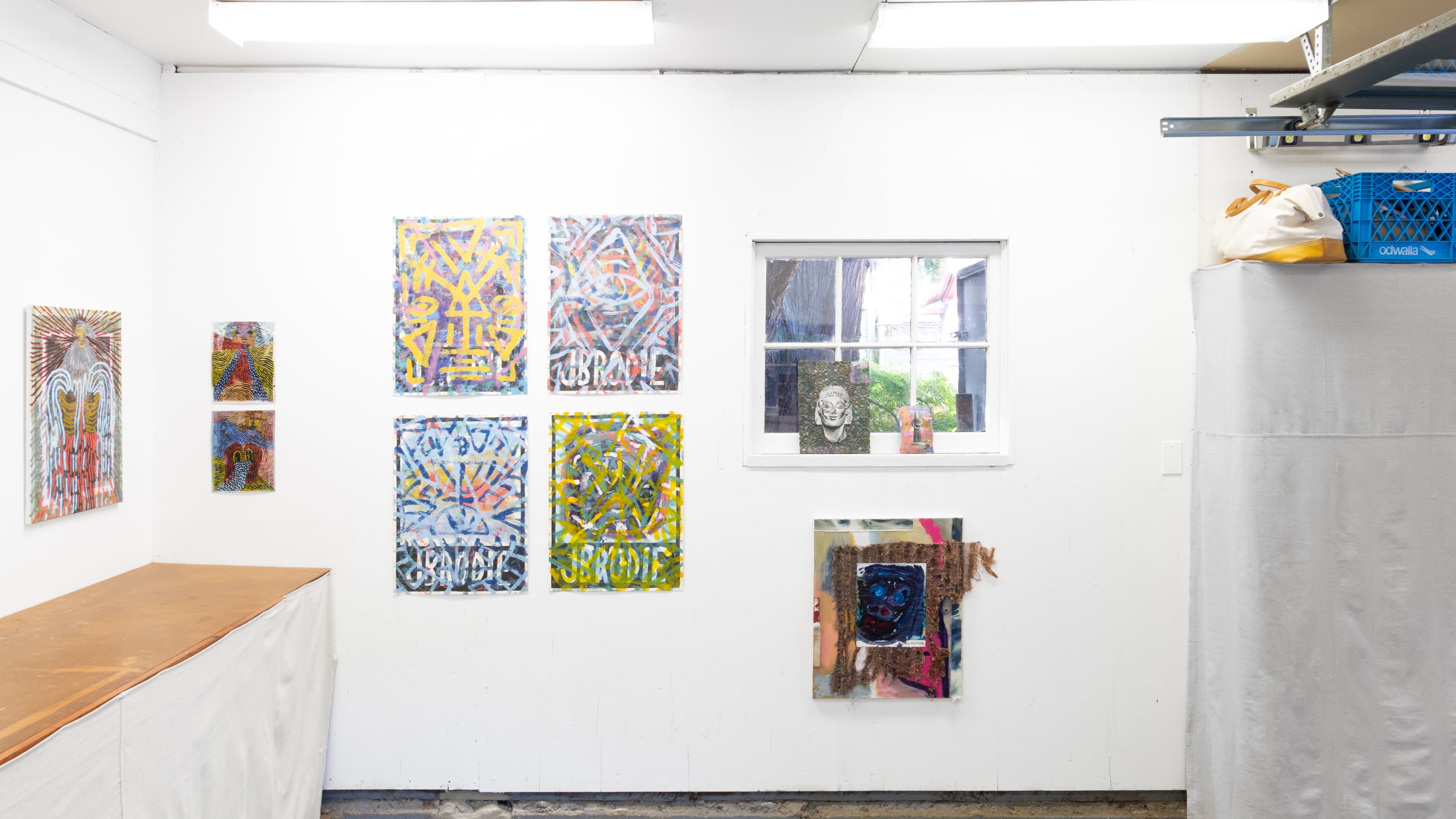Friends of Doom would be a good name for a band, but it’s actually the title of John Brodie’s latest show at Old Fashioned Garage Gallery, an alternative art space in the Irvington area, a recent addition to Portland’s vibrant art scene. On view through June 29, Brodie’s new body of work, created this year, seamlessly blends painting, collage, drawing and three-dimensional mixed-media sculpture. Throughout the exhibition, Brodie explores mark making, layers and repetition.
Many of the canvases feature an underpainting of older artistic endeavors that were previously set aside. This abandoned work is creatively recycled, serving as a fresh starting point for reimagining new and current pieces. Borrowed imagery is a consistent theme in this collection, drawing from ancient civilizations like the Greeks and Mesopotamians as well as the cultural zeitgeist, such as luxury fashion magazine ads. These recurring images are presented across multiple works, establishing a visual language for viewers to interpret. Brodie continuously absorbs imagery, a practice evident from his role in selecting books, prints and ephemera for his Alberta Arts District bookstore, Monograph Bookwerks.
Brodie’s brushstrokes possess an expressive and energetic fervor, moving dynamically across the canvas or adorning collaged imagery. In How Are You Feeling II (Prada), a model’s pouty head emerges from a Greek bust, with fiery orange lines extending beyond. Thick powder-blue lines pour from the statue’s vacant eyes while golden yellow fringe stretches across the rest of the statue like a decorative mask.
A cosmic tilt is evident in Brodie’s mark making, with lines radiating outward from the canvas and collaged imagery. Louis with Ghosts features tangerine and seafoam-green lines emanating from the statue’s eyes and mouth, encircled in bright red. Queen (Chloé) showcases mystical, swirling, cascading and emotive line work painted over a collaged Chloé ad and a Greek statue, hinting at impending deification. LV LV (Plant) feels more grounded than celestial, with perceived references to the natural world, yet remains equally ritualistic. Curvy flowing strokes mimic a river or a path toward the heavens. Red concentric lines form a halo over a smizing face, and a plant seemingly grows out of a rock next to the Louis Vuitton name. Crying (Chloé) also appears centered in the earthly realm, with vertical dashes dotting down the page like rain and diagonal expressive lines extending out like sunbeams.
High-end fashion magazine ads are a recurring element, collaged into canvases alongside textiles and then embellished with figurative faces in works like CK+LV Flag and Prada Please (Doomsday). These pieces are infused with playfulness and humor. D&G Doggo is arguably the most comical, featuring two exaggerated asymmetrical black-and-white cartoon eyes and bright pink nostrils covering a Dolce & Gabbana advertisement layered on dyed textile and canvas. In contrast, Cosmology showcases geometric shapes (rectangles, diamonds and a singular eye) coming into focus atop more gestural abstract elements.
Crochet and textiles are extensively used throughout the works, such as in Red Vase and Blue Vase, providing texture and ornamentation against uncomplicated depictions of vases. Gods of Medicine and Starfisher also incorporate needleworked fibers in their formation. However, these pieces, along with Small Friends, are unique as three-dimensional collage paintings. They maintain the recurring theme of pairing figures from antiquity with emotional abstraction. These pieces possess physical depth, with gessoed paper providing structure and volume.
Several pieces are displayed beyond the confines of the garage gallery walls. Subtly placed on one of the pergola’s beams directly outside, Versace Hex features a figurative cubist sculpture and a Greek bust on honeycomb cardboard in various colors. Another piece, Untitled, showcases an abstracted blue face painted over a Versace ad with a wallpaper-print background. Placing artwork outside a traditional gallery setting is a welcome disruption to art viewing, aligning with the residential nature of Old Fashioned Garage Gallery beyond the white walls of a gallery.
Friends of Doom is the second exhibition in a series of exhibitions Old Fashioned Garage Gallery plans to host this year. This collaborative project by Jodie Cavalier, whose show Strange Overtones we reviewed in March, and Alley Frey transforms their garage in Northeast Portland into an art gallery. The space evokes a sense of nostalgia for a time, about a decade ago, when art shows would frequently pop up in people’s basements, backyards and, as the name suggests, garages.
Residential art spaces are not a new concept, generally or within the city; they have existed as long as artists have been creating. However, the consistent emergence of new artist-run spaces has slowed in recent years. Part of their beauty lies in their often short-lived and impermanent nature, making it crucial to embrace them while they are active. There is grit and thoughtfulness, seriousness and playfulness in both Brodie’s work and the way Cavalier and Frey curate and exhibit artists in their space.
SEE IT: Friends of Doom by John Brodie at Old Fashioned Garage Gallery, oldfashionedgaragegallery.wordpress.com. Open by appointment through June 29.

